#color advice
Explore tagged Tumblr posts
Text



Meeks tries to explain how they color, except it is disjointed because you can’t explain years of color theory and practice in one post.
I wanted to beat the allegations that I only draw warm colors so I made this Javier drawing with cool colors. Okay… well, cooler colors. I will never draw with strictly blue. Dark blue is my enemy.
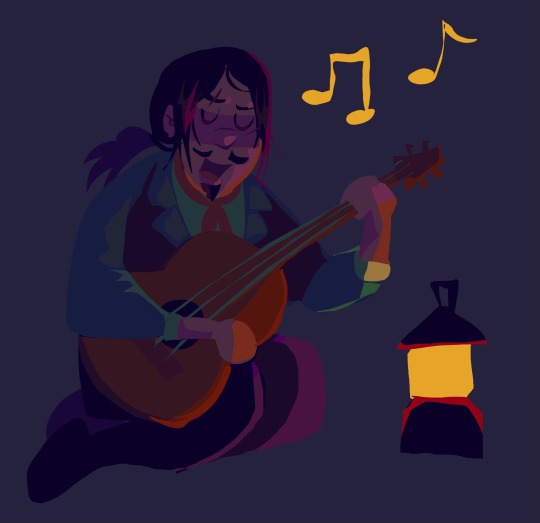
#rdr2#javier esquella#javier escuella#art advice#art tutorial#color theory#color advice#art#artists of tumblr#red dead redemption 2 fanart#red dead redemption two#my genuine advice is to fuck around and experiment#look up artists with saturated art and see how they work with it#there is a fine line between eye strain and appealing to look at#take all this with a grain of salt. these are just my opinions#meek’s art
81 notes
·
View notes
Text
COLOURS in DESCRIPTION
colour is the lifeblood of a scene. here are ways not to over-use it.
Red: cardinal, coral, crimson, flaming, maroon, rose, wine, brick red, burgundy, carmine, cerise, cherry, chestnut, claret, copper, dahlia, fuschia, garnet, geranium, infrared, magenta, puce, ruby, russet, rust, salmon, sanguine, scarlet, tition, vermilion, roseate, rubicund, ruddy, rubescent, florid
Orange: apricot, tangerine, merigold, cider, ginger, bronze, cantaloupe orange, clay, honey, marmalade orange, amber
Yellow: blond, chrome, cream, gold, ivory, lemon, saffron, tawny, xanthous, sandy
Green: grassy, leafy, verdant, emerald, aquamarine, chartreuse, fir, forest green, jade, lime, malachite, mossy, pea green, pine, sage, sea green, verdigris, willow, spinach green, viridian
Blue: azure, beryl, cerulean, cobalt, indigo, navy, royal blue, sapphire, teal, turquoise, ultramarine
Purple: violet, indigo, lavender, lilac, mauve, periwinkle, plum, violet, amethyst, heliotrope, mulberry, orchid, pomegranate purple, wine, amaranthine, perse, violaceous, reddish-blue
#writing#creative writing#writers on tumblr#writeblr#writerscommunity#writers and poets#writing inspiration#writing advice#writing ideas#writing tumblr#character description#description#colors#colorful#scenery
9K notes
·
View notes
Text
Steve Harrington who has been trying for weeks (maybe even months) to woo Eddie and keeps failing UNTIL he makes an offhand comment correctly referencing one of the groups nerd books. Weeks and weeks of using smooth lines that have never failed him until Eddie, and this is what gets him the guy? Nerd lingo he’s learned purely through osmosis.
Steve who is just standing there like “really? That’s what did it for you? Jesus Christ I can’t believe I’m going to kiss you.”
Eddie, completely shocked by this turn of events: “you want to kiss me?????”
And the whole party is in the background like: “he has for a while thank you for finally catching up before we took drastic measures”
#steddie#steve harrington#eddie munson#the party#idiot for idiot#stranger things#they were going to invent a new color code purely for eddie and Steve’s situation#the party was so tired of them#poor Steve was failing so hard#robin made a new board for it#there were so many strike out lines she started to secretly erase some of them because she felt bad#the kids kept giving Steve advice. unsolicited.#all of the advice was bad
2K notes
·
View notes
Text
Boston Bedroom Master

An illustration of a medium-sized country master bedroom with gray walls and a light wood floor.
#perfect gray paint#grey walls#master bedroom#color advice#perfect medium gray paint#color consultant
0 notes
Text

They're judging their sibling's life decisions, and they are not impressed.
(And to think Jason and Dami have pit-madness in their system)
#color study#My fanarts levels depends on my adhd serotonin#Procastination it is#But they are so prettyyy so i am happy#dc comics#damian wayne#fanart#dc#robin#jason todd#red hood#If i dont doodle my artstyle revert to anime and i need to restudy human face anatomy and sometimes i love it sometimes i dont#Right now i love it#apparently if i want to put two days worth of work on a fanart it doesnt look bad huh#Also been using orange and red again on my skintones...i have been warching this youtube shorts guy that gives advice for art corrections#And its great#Had mild colorblindness so dont know how it looked on you guys but for me it looked good enough#if i make it orange again then just blame it tk artistic freedom lol
2K notes
·
View notes
Text
I'm gonna go ahead and say this one more time, as someone whose ancestors literally evolved traditional medicine, 'cause I been seeing some dumb shit on social media again.
The average joe schmol doesn't possess enough knowledge of actual traditional medicine to know what the hell they're doing. Chances are, they end up whipping some rando concoction that at best does nothing, at worst is toxic.
The difference between medicine and poison is often the dosage.
Herbalism, alternative healing, home remedies, they do have their places in the modern world. But unless you really know what the fuck you're doing, you're better off and much safer with something FDA approved, than listen to some white lady with dreadlocks on TikTok who calls herself a "natural healer" and literally teaches you how to poison yourself.
I research and study herbs for fun, and my herb collection is way bigger and more practical than some souped up pretty picture on the internet. And you know what's the first thing I go for when I have a migraine? Excedrin.
When in doubt, modern medicine first, everything else supplemental.
#mother witch advice#witches of color#witchblr#witch community#witches of tumblr#herbalism#traditional medicine#nature magic#hearth witch#wise woman#asian witch
633 notes
·
View notes
Text

Sending the Kids Off to Fight Crime With Even More Crime
Leverage (2008-2012)
The Juror #6 Job
#hehehe finally finishing my ot3 gifset for this episode#but couldn’t quite figure out how to crop this just to get the ot3#so I’m putting it here rn until I figure it out#but someone please I beg of you#why if my gifs get to a certain amount of frames?#size?#it starts to get blurry#I know it’s because I’m condensing it to fit tumblrs size limit#but ughhhhh I hate it when my gifs look inconsistent because they start to get fuzzy depending on size#if anyone has any advice please lmk because I cannot figure it out#I mean this show is mid 2000s so I know it’s gonna be a bit hard to clear up grain and color grade#but like I hate how they come out sometimes#maybe I’m just picky#anywayssssss#leverage#the juror 6 job#inde gifs#inde gifs: the juror 6 job#inde gifs: leverage ot3#ot3: hitter hacker thief#leverage ot3#the leverage ot3 in every episode#inde gifs: the leverage ot3 in every episode
456 notes
·
View notes
Text
🎨 ~ Color Theory & Design Tutorial ~ 🖌️
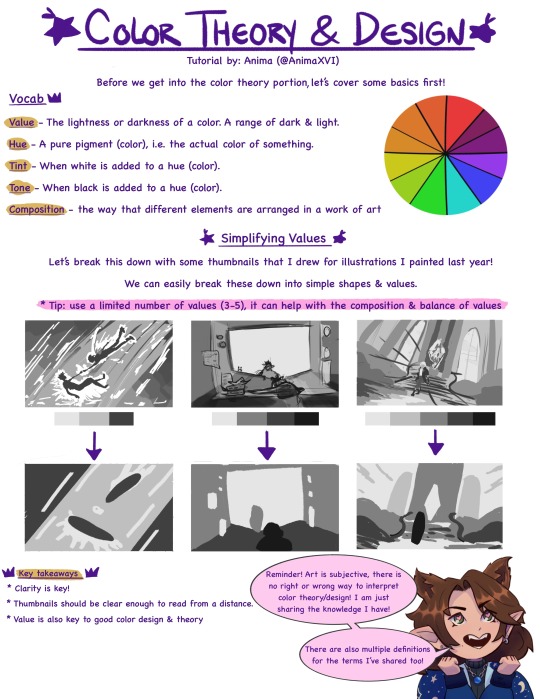
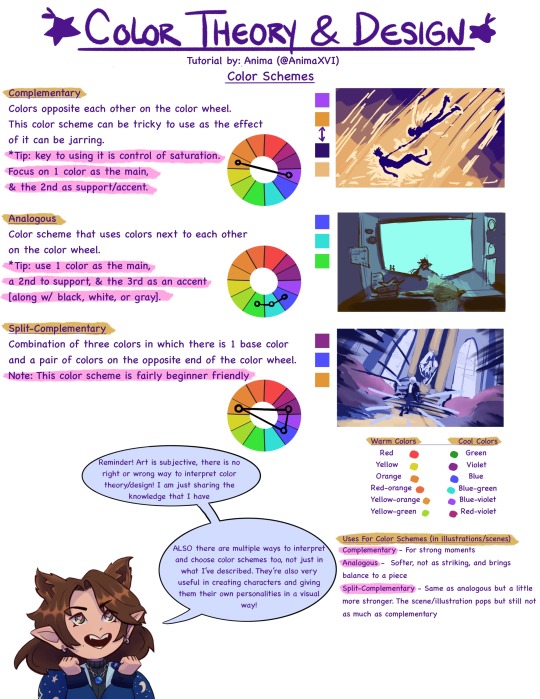
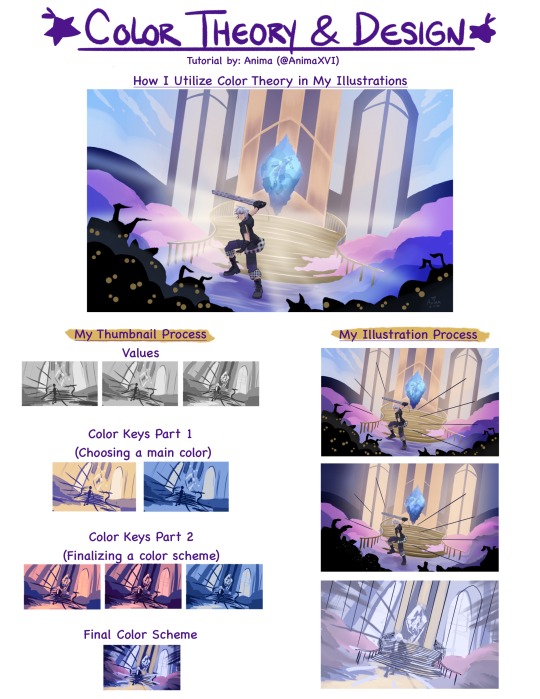
I've been thinking about making tutorials for a while now. So I thought I'd share about a subject I'm really passionate about! I did my best to make this beginner friendly & also as a review sheet 💜
(Please note this is from my own knowledge/experience! There are waaaay more resources, like books & videos, out there that are super helpful and go further in depth of this topic!)
#art tutorial#color theory tutorial#color theory#artists on tumblr#art advice#color scheme#color design
1K notes
·
View notes
Text
I’m afraid my character has stereotypical traits. How do I avoid making them a caricature?
Is your character composed of several stereotypical traits, or is it just the one? Are they allowed to act and think in ways that are not confined to stereotypes? The more three-dimensional your character is, the less they are defined by the stereotypes.
One strategy that works in some cases is the “offset” character. This refers to weakening character A’s stereotype by including a character B of the same identity who isn’t stereotypical in that way. Say you have a selfless, “motherly” Black woman who looks after the cast. In addition to developing her own arc and her own desires, try adding a Black woman character with 0 maternal instinct who goes full steam ahead with her goals.
Trace your logic as to why you decided to give certain traits to a character of a certain identity. Our aptly named #trace your logic tag contains examples where we prompt the asker to interrogate their intentions behind certain ideas. Try to ask yourself the same questions.
Further reading:
Tropes and Stereotypes
Stereotyped vs Nuanced Characters and Audience Perception
---
This Q&A is an excerpt from our General FAQ for Newcomers, which can be found in our new Masterpost of rules and FAQs. For more advice on writing with diversity, start there!
-Writing With Color
#writing with color#writeblr#representation#poc representation#lgbt representation#writing advice#writing tips#writers on tumblr#faq
2K notes
·
View notes
Text

repost , figured this would be handy for somebody
#robin gives advice 🦇#art advice#advice#my art#digital art#art#artists on tumblr#digital artist#color theory#art resources#art tutorials
497 notes
·
View notes
Text
A Quick Guide to Colour Symbolism
Colour symbolism has been a long-standing part of the writers' craft. Colours can hold different meanings across various cultures, but here are some common examples of some colours and their associated imagery.
🍎 Red: Love, lust, anger, danger, violence, passion
💎 Blue: Tranquillity, calm, peace, sadness, isolation
🥬 Green: Jealousy, rebirth, growth, greed, renewal
♠️ Black: Death, sadness, loss, grief, evil, depression
🎀 Pink: Sweetness, love, kindness, innocence
🍊 Orange: Joy, creativity, energy, excitement
🌼 Yellow: Joy, cowardice, innocence, optimism
🏳️ White: Innocence, faith, peace, purity, mourning
🐴 Brown: Stability, comfort, predictability, boredom
💟 Purple: Royalty, bravery, virtue, luxury, spirituality
#writers#creative writing#writing#writing community#writers of tumblr#creative writers#writing inspiration#writeblr#writing tips#writerblr#writblr#color meanings#color symbolism#writing advice#writing resources#references for writers#help for writers#writing help#creative writing tips#quick writing tips
3K notes
·
View notes
Text
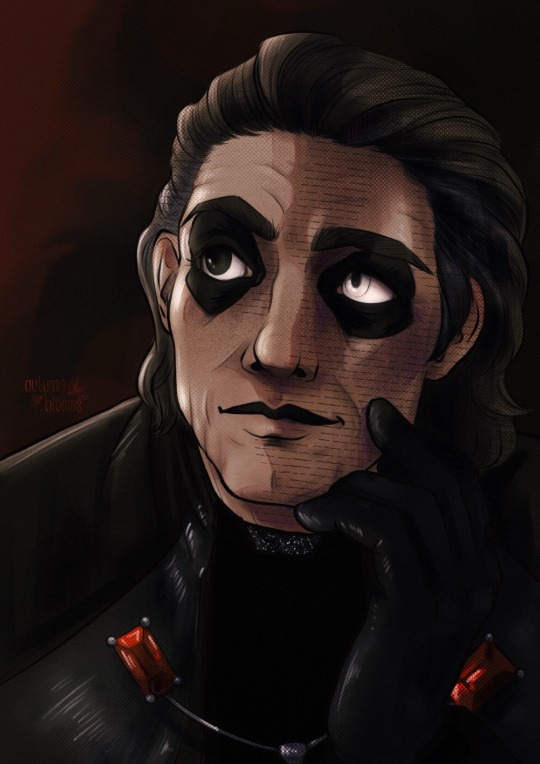
I’m still not over this
I found some new Procreate brushes today~
#Not sure how I feel about this but new brushes always help break up the art block so…#we’re getting somewhere#trying to do more textures and non-local color#color theory is not my strong suit though so if anyone has advice please hit me up#the band ghost#my art#frater imperator#cardinal copia#papa emeritus iv#ghost band#father imperator
442 notes
·
View notes
Text
spare time
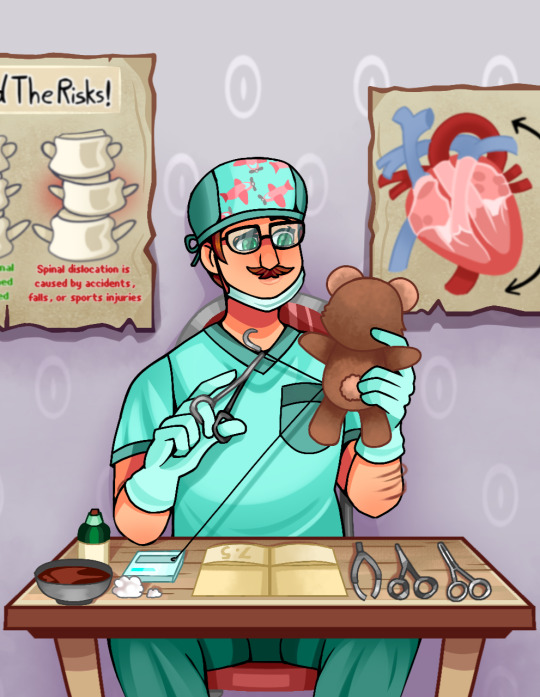
This meme is quite LITERALLY him

#The teddy bear is probably either Vincent's or Jas's#The suture is silk and is correctly color coded cuz I'm a nerd#The posters are my own interpretations of the canon posters in his clinic examination room cuz I'm a NERD#He probably also gave extensive post-surgery care advice to the teddy bear's owner#The plane pattern on scrub hat idea was from an irl friend they are SO REAL for that#harvey stardew valley#sdv harvey#harvey sdv#Stardew valley harvey#stardew valley fanart#stardew valley
598 notes
·
View notes
Text
Different ways to describe Blue eyes
1. Bright, azure eyes: Referring to the brilliant, vivid shade of blue reminiscent of a clear sky.
2. Deep sapphire eyes: Comparing the color to the rich, dark blue of a sapphire gemstone.
3. Clear cerulean eyes: Describing a pure, bright blue hue akin to the color of a clear cerulean sky.
4. Sparkling turquoise eyes: Likening the color to the shimmering, greenish-blue tones found in turquoise gemstones.
5. Icy blue eyes: Describing a pale, cool blue shade reminiscent of ice or winter.
6. Piercing cobalt eyes: Suggesting a striking, intense blue color akin to cobalt metal.
7. Dreamy cornflower eyes: Comparing the color to the soft, delicate shade of cornflower petals.
8. Electric blue eyes: Referring to a vibrant, intense blue hue that appears to be charged with energy.
9. Oceanic blue eyes: Describing a deep, alluring blue color reminiscent of the vastness of the ocean.
10. Steel-blue eyes: Likening the color to the cool, steely hue of metal.
11. Aquamarine eyes: Comparing the color to the soft, bluish-green tones of the gemstone aquamarine.
12. Gentle baby blue eyes: Describing a light, soft blue color similar to the eyes of a newborn.
13. Enchanting cerulean eyes: Suggesting a captivating, magical shade of blue.
14. Cool periwinkle eyes: Referring to a soft, light blue hue with a touch of lavender.
#writing#writer on tumblr#writerscommunity#writing tips#character development#writer tumblr#writblr#writing advice#oc character#writing help#writers on tumblr#creative writing#color eyes#introducing my ocs
2K notes
·
View notes
Text

And for those who don't know, you can't get magenta by mixing. You'll need to buy it.
Edit: Quick observation, this advice is for mixing paints and pigments, other mediums have different color specifications.
#painting#art#artist on tumblr#art community#color theory#watercolor#oil painting#gouache#acrilic painting#oil paint#acrilic paint#art tumblr#art tips#memes#art memes#artist#art advice#art help
1K notes
·
View notes
Note
Hiiiiii for that pre king wish au. Is Loop going to deal with the repercussions of Siffrin always drifting and never finding an anchor? He was just a traveller, moving forward day by day, with nothing new or exciting to live for... until he met the family :3 BUT NOT WITHOUT THE KING-
OK SO. i have Many Thoughts about this, so bare with me here.
Loop, having gone through the Same Two Days for so long they've lost count of time, has a complicated relation with predictability and stagnation. On one hand, if nothing changes, then they can just follow the script, and they'll know what to expect. On the other hand, they'd rather die than be stuck repeating the same lines over and over again, not after finally being freed. And now, by a twist of fate, they're face to face with the past version of the monster they were fighting so hard to defeat.
I think, at first, they stick around as a helpful "guiding figure" while they sort through their own feelings and decide if they're gonna kill this guy or not. After much deliberation and one failed murder attempt, they decide to let him be. Unfortunately for them, in this time they've grown attached to the sobbing wet cat of a man they were stuck with (the King is actually very similar to Siffrin in this AU, so he probably hits a soft spot within Loop, that remembers the horrible feeling of confusion when they first landed in Vaugarde).
After the emotional tumult settles, I think that King intends to go to Corbeaux as per cannon, and Loop (without any better things to do), follows. On the way there, though, they pass by Bambouche, and Loop is hit by the Dread as they watch a slightly younger Bonnie with their sister run by them without giving them a second glance (well, they do look their way, but with confusion and curiosity instead of recognition). That's when it hits Loop that no one in their family is ever going to meet each other because the disaster they bonded over never happens.
I'm still mulling over how I'm gonna make this happen, but I want Loop to put the gang back together with the King's help (maybe on the pretense of finding more about the forgotten nation?). Loop clings to this purpose like a goddamn lifeline, because otherwise, as you mentioned, they would just go back to wandering aimlessly, stumbling around in a land that is not theirs. They want their happy ending because, after All of This? They deserve it.
(On an addendum, there is also a Siffrin in this AU, back when they still kept his hair dyed black.)
(On a second note, I'm currently making those in-game character profiles for the ones who don't have them yet - Loop, King and Nille - so. Uh. There is more to come 👍)
#isat#in stars and time#isat spoilers#in stars and time spoilers#two hats spoilers#isat au#it never happens au#oh ye btw#you know those art advice posts#that say that the best way to get better at art quickly is to get obsessed with one (1) character?#yeah i have to agree with them#drawing the sillies has made me surprisingly competent at copying the game's artstyle#and a lot better at working with a limited color palette#ANYWAYS! character portraits Soon (in like a few days maybe)
150 notes
·
View notes